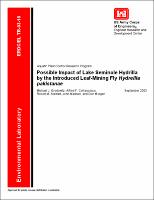Please use this identifier to cite or link to this item:
https://hdl.handle.net/11681/7051| Title: | Possible impact of Lake Seminole hydrilla by the introduced leaf-mining fly Hydrellia Pakistanae |
| Authors: | Grodowitz, Michael Jay Cofrancesco, Alfred F., Jr. Stewart, R. Michael Madsen, John Douglas Morgan, Donald M. |
| Keywords: | Hydrilla--Control Biological pest control agents |
| Publisher: | Environmental Laboratory (U.S.) Engineer Research and Development Center (U.S.) |
| Series/Report no.: | ERDC/EL ; TR-03-18. |
| Abstract: | Abstract: Hydrellia pakistanae, a biological control agent of hydrilla, was first introduced into Lake Seminole in 1990. Impact by this species remained low until 1998 when large numbers of individuals and associated impact, as well as increases in native plant diversity, were observed in several locations. In 1999, large-scale reductions in hydrilla were observed throughout many areas of the lake. These changes were correlated with changes in insect numbers where large increases in fly populations were correlated with decreases in tuber numbers and increases in species richness. While insect numbers were reduced in 2000, significant decreases in biomass and increases in native plant diversity were observed when numbers of immatures and/or feeding damage were high. While the evidence presented herein indicates that the flies played a major role in the hydrilla decline on Lake Seminole, other factors may have contributed to the observed reductions. This includes such obvious changes as decreases in lake levels brought on by drought that may have increased light penetration in shallower areas, thus allowing for increased growth of natives. More likely, a complex of factors, including H. pakistanae feeding damage, contributed to the observed changes in hydrilla status on Lake Seminole. |
| URI: | http://hdl.handle.net/11681/7051 |
| Appears in Collections: | Technical Report |
Files in This Item:
| File | Description | Size | Format | |
|---|---|---|---|---|
| ERDC-EL TR-03-18.pdf | 3.2 MB | Adobe PDF |  View/Open |